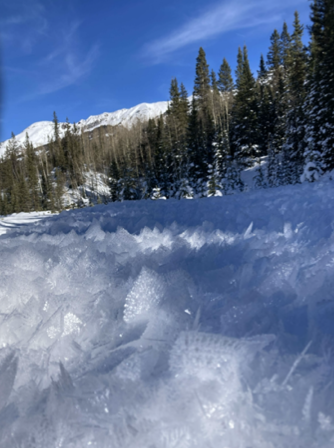Hoar Frost!

Written by Jennifer Cram
Note: I have a Ph.D. in Meteorology but had to come home and google this. I probably learned this a long time ago but it wasn't something I thought about much until I saw these beautiful crystals!
Lately there have been amazing displays of hoar frost around Ironton. A group of OTG members went snowshoeing up there on Saturday 12/7 – the following pics are from that trip. However, it's not uncommon to see hoar frost up there – keep reading and see why!
Hoar frost is the beautiful feathery frost that you sometimes see, while 'regular' frost is is the white coating you see on grass on a cold morning. Both of them form when water vapor (vapor not liquid!) freezes on contact with a below-freezing object – it could be the ground or a tree branch or a snow bank. The ice crystals in hoar frost grow in beautiful and very delicate shapes – sometimes as large as an inch or 2. That much growth requires time (probably 6 hours or so), high humidity (so there is enough water vapor to keep growing the crystals), very cold air, and very still air. Surface hoar is when the crystals grow on top of the snow, but crystals can also form on tree branches or twigs. Surface hoar that gets buried by subsequent snowfall can result in a weak layer in the subsequent snowpack and thus increased avalanche risk.
Where and when can I see it? First of all, it needs to be very cold so the crystals have formed but not melted – that means early morning or a very cold air. Clear, still nights lead to the best conditions – lots of radiational cooling. Also, you will most likely see it near areas where there is a nearby open stream (more moisture), but you do also see it where the moisture could be coming up from the internal snowpack. No wind is important both for keeping it cooler (no mixing) and not breaking the crystals. Get out and explore and enjoy!
- Hits: 131